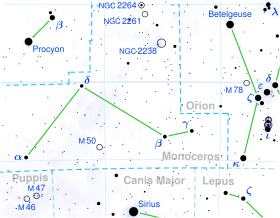Star in the constellation Monoceros
Delta Monocerotis
Location of δ Monocerotis (circled)
Observation dataEpoch J2000 Equinox J2000
Constellation
Monoceros
Right ascension 07h 11m 51.860s [ 1]
Declination
−00° 29′ 33.96″[ 1]
Apparent magnitude (V)4.15[ 2]
Characteristics
Spectral type
A2V[ 3] [ 4]
U−B color index
+0.04[ 5]
B−V color index
+0.00[ 5]
Astrometry Radial velocity (Rv )± 4.1[ 6] Proper motion (μ) RA: +0.79[ 7] mas /yr Dec.: +4.52[ 7] mas /yr Parallax (π)8.49 ± 0.17 mas [ 7] Distance 384 ± 8 ly pc ) Absolute magnitude (MV )−1.20[ 2] Details Mass +0.43 [ 3] M ☉ Luminosity 350[ 8] L ☉ Surface gravity (log g )± 0.25[ 3] cgs Temperature 9,462[ 8] K Metallicity 0.00[ 9] dex Rotational velocity (v sin i )± 1.3[ 10] Age +135 [ 3] Myr Other designations δ Mon ,
22 Monocerotis ,
BD −00°1636,
FK5 1187,
GC 9518,
HD 55185,
HIP 34769,
HR 2714,
SAO 134330,
CCDM J07119-0030A,
WDS J07119-0030A[ 11] Database references SIMBAD data
Delta Monocerotis , which is Latinized from δ Monocerotis, is a single star [ 12] constellation of Monoceros , positioned about a half degree south of the celestial equator . It has a white hue and is faintly visible to the naked eye with an apparent visual magnitude of 4.15.[ 2] light years based on parallax .[ 7] Sun with a radial velocity of about +15 km/s,[ 6] [ 2] absolute magnitude of −1.20.[ 2]
The Bright Star Catalogue stellar classification of A2V, suggesting this is an A-type main-sequence star .[ 3] [ 13] evolved subgiant class of A0IV.[ 4] mass of the Sun and is an estimated 405 million years old.[ 3] projected rotational velocity of 175.5 km/s,[ 10] equatorial bulge that is 5% larger than the polar radius.[ 14] luminosity of the Sun from its photosphere at an effective temperature of 9,462 K.[ 8]
It has one reported visual companion , designated component B, at an angular separation of ″ [ 15]
References
^ a b Høg, E.; et al. (2000). "The Tycho-2 catalogue of the 2.5 million brightest stars". Astronomy and Astrophysics . 355 : L27. Bibcode :2000A&A...355L..27H . ^ a b c d e Anderson, E.; Francis, Ch. (2012). "XHIP: An extended hipparcos compilation". Astronomy Letters . 38 (5): 331. arXiv :1108.4971 Bibcode :2012AstL...38..331A . doi :10.1134/S1063773712050015 . S2CID 119257644 . Vizier catalog entry ^ a b c d e f Gullikson, Kevin; et al. (August 2016). "The Close Companion Mass-ratio Distribution of Intermediate-mass Stars" . The Astronomical Journal . 152 (2): 13. arXiv :1604.06456 Bibcode :2016AJ....152...40G . doi :10.3847/0004-6256/152/2/40 S2CID 119179065 . 40. ^ a b Houk, N.; Swift, C. (1999). "Michigan catalogue of two-dimensional spectral types for the HD Stars". Michigan Spectral Survey . 5 . Bibcode :1999MSS...C05....0H . ^ a b Mallama, A. (2014). "Sloan Magnitudes for the Brightest Stars". The Journal of the American Association of Variable Star Observers . 42 (2): 443. Bibcode :2014JAVSO..42..443M . Vizier catalog entry ^ a b Gontcharov, G. A. (2006). "Pulkovo Compilation of Radial Velocities for 35 495 Hipparcos stars in a common system". Astronomy Letters . 32 (11): 759– 771. arXiv :1606.08053 Bibcode :2006AstL...32..759G . doi :10.1134/S1063773706110065 . S2CID 119231169 . ^ a b c d Van Leeuwen, F. (2007). "Validation of the new Hipparcos reduction". Astronomy and Astrophysics . 474 (2): 653– 664. arXiv :0708.1752 Bibcode :2007A&A...474..653V . doi :10.1051/0004-6361:20078357 . S2CID 18759600 . Vizier catalog entry ^ a b c Zorec, J.; Royer, F. (2012). "Rotational velocities of A-type stars". Astronomy & Astrophysics . 537 : A120. arXiv :1201.2052 Bibcode :2012A&A...537A.120Z . doi :10.1051/0004-6361/201117691 . S2CID 55586789 . Vizier catalog entry ^ Gontcharov, G. A. (2012). "Dependence of kinematics on the age of stars in the solar neighborhood". Astronomy Letters . 38 (12): 771– 782. arXiv :1606.08814 Bibcode :2012AstL...38..771G . doi :10.1134/S1063773712120031 . S2CID 118345778 . Vizier catalog entry ^ a b Díaz, C. G.; et al. (July 2011). "Accurate stellar rotational velocities using the Fourier transform of the cross correlation maximum". Astronomy & Astrophysics . 531 : A143. arXiv :1012.4858 Bibcode :2011A&A...531A.143D . doi :10.1051/0004-6361/201016386 . S2CID 119286673 . ^ "del Mon" . SIMBAD Centre de données astronomiques de Strasbourg . Retrieved 2020-08-29 .{{cite web }}: CS1 maint: postscript (link )^ Eggleton, P. P.; Tokovinin, A. A. (September 2008). "A catalogue of multiplicity among bright stellar systems" . Monthly Notices of the Royal Astronomical Society . 389 (2): 869– 879. arXiv :0806.2878 Bibcode :2008MNRAS.389..869E . doi :10.1111/j.1365-2966.2008.13596.x S2CID 14878976 . ^ Hoffleit, D.; Warren, W. H. (1995). "Bright Star Catalogue, 5th Revised Ed. (Hoffleit+, 1991)". VizieR On-line Data Catalog: V/50. Originally Published in: 1964BS....C......0H . 5050 . Bibcode :1995yCat.5050....0H . ^ van Belle, Gerard T. (March 2012). "Interferometric observations of rapidly rotating stars". The Astronomy and Astrophysics Review . 20 (1): 51. arXiv :1204.2572 Bibcode :2012A&ARv..20...51V . doi :10.1007/s00159-012-0051-2 . S2CID 119273474 . ^ Dommanget, J.; Nys, O. (2002). "VizieR Online Data Catalog: CCDM (Catalog of Components of Double & Multiple stars) (Dommanget+ 2002)". VizieR On-line Data Catalog: I/274. Originally Published in: Observations et Travaux 54 . 1274 . Bibcode :2002yCat.1274....0D . Vizier catalog entry
